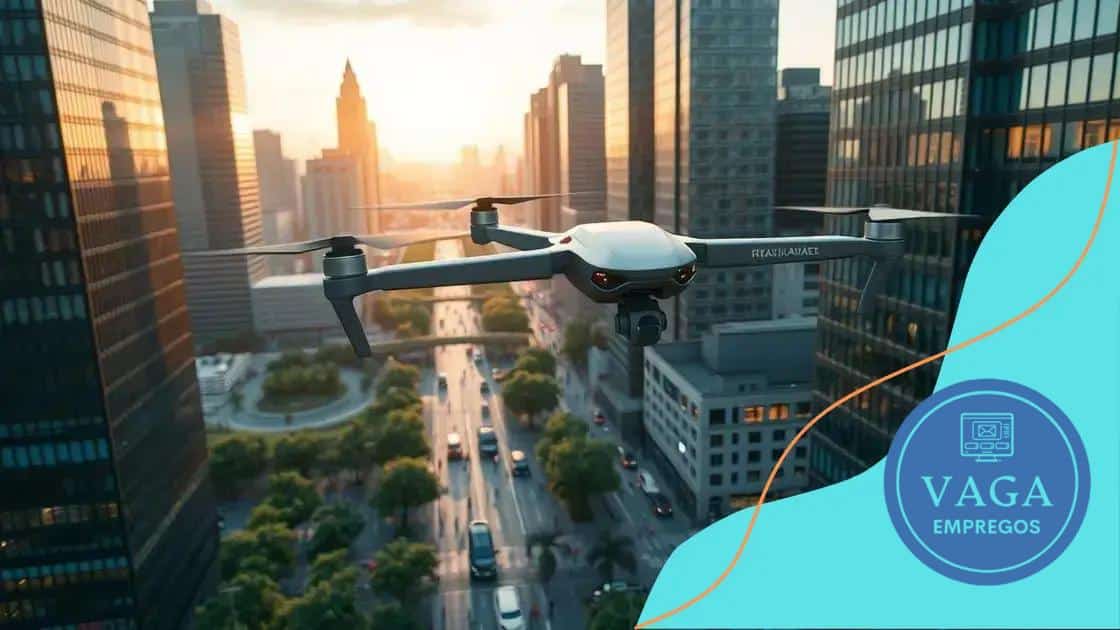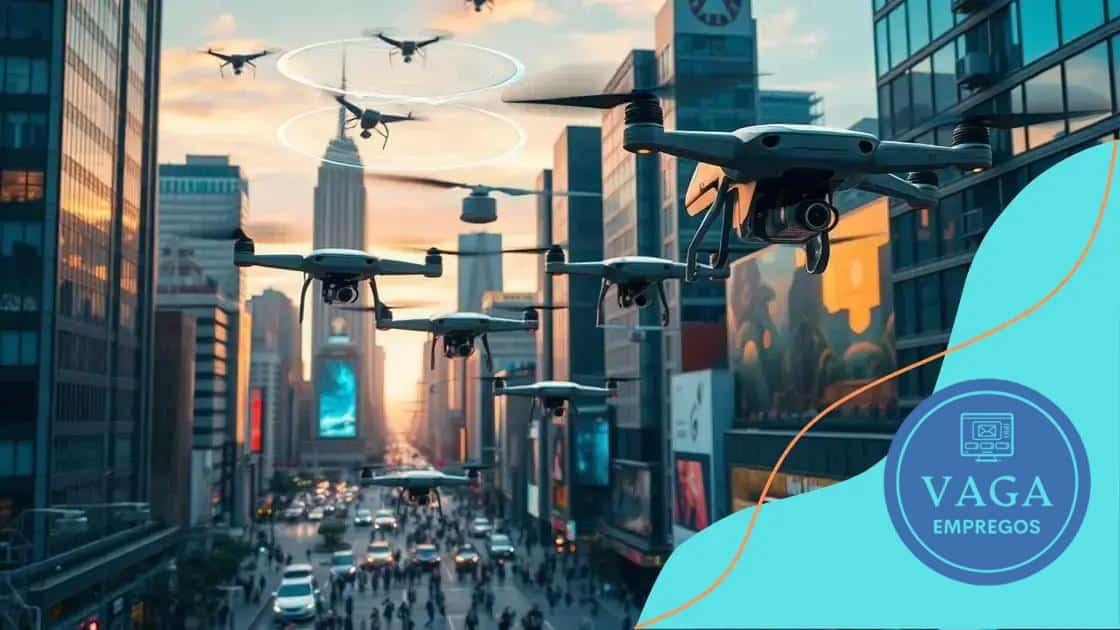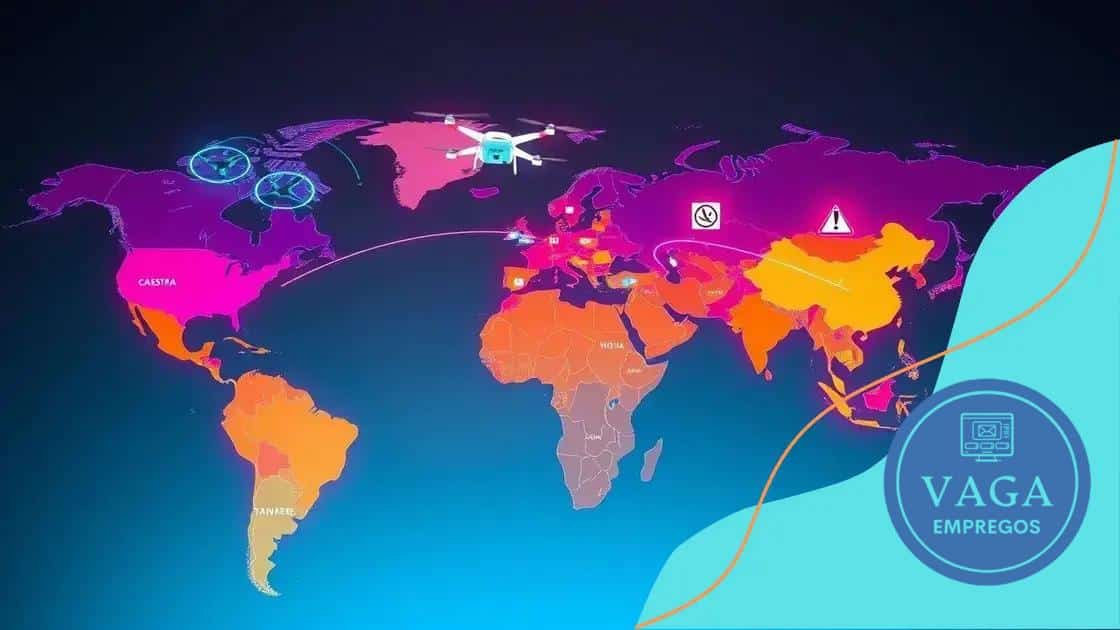Regulation of autonomous drones takes center stage

Advertisement
The regulation of autonomous drones is evolving to ensure safety, promote innovation, and address privacy concerns, with global collaboration leading to more standardized and adaptive frameworks.
Regulation of autonomous drones takes center stage as technology evolves rapidly. With drones becoming commonplace in various industries, ensuring their safe and responsible use is more important than ever. What are the key issues surrounding these regulations?
Advertisement
Understanding the current landscape of drone regulations
Understanding the current landscape of drone regulations is crucial for industry stakeholders and recreational users alike. As autonomous drones gain popularity across various sectors, the need for regulations becomes increasingly apparent. This ensures safety, privacy, and compliance with air traffic rules.
Advertisement
Key regulations in place
Countries around the world are establishing specific rules governing the use of drones. These regulations cover aspects such as registration, operational limits, and safety requirements. For example, in the United States, the Federal Aviation Administration (FAA) has established comprehensive guidelines that all drone operators must follow.
- Mandatory registration for drones over a specific weight.
- Restrictions on flying drones near airports and over crowds.
- Height limitations for drone operations.
In addition to national regulations, local laws can also impact drone usage. It’s essential for operators to be aware of local laws that might apply, including zoning ordinances or privacy laws. Different countries have unique regulations that can present challenges for cross-border drone usage.
Global perspectives
Globally, regulations can vary widely. For instance, while some countries have embraced the use of drones for commercial purposes, others impose strict limitations. In Europe, regulations enforced by the European Union aim for a unified approach to drone operation across member states. These regulations promote safety while encouraging innovation.
Regulation is not solely about restrictions. It can also foster advancement in the technology behind drones. By ensuring safety and accountability, regulations can boost public trust in drone technology, paving the way for more extensive use in areas such as delivery services and surveillance.
The role of technology
As drone technology continues to evolve, so too must the regulations surrounding it. Emerging technologies such as detect-and-avoid systems and automation present new considerations for regulators. These advancements not only enhance safety but also influence how current laws may be adapted in the future.
Key challenges in regulating autonomous drones

Key challenges in regulating autonomous drones arise as their use becomes more widespread. While these drones offer incredible benefits, they also present unique difficulties for regulators. Identifying how to balance innovation with safety is a primary concern.
Complexity of Airspace Management
One major challenge is managing airspace effectively. With the growing number of drones, ensuring that they can safely share the skies with manned aircraft is essential. This requires precise coordination and comprehensive tracking systems to avoid accidents.
- Implementing effective air traffic control for drones.
- Ensuring real-time data sharing between drone operators.
- Creating designated airspace zones for safe drone operation.
Additionally, drones come in various sizes and functionalities, adding to the complexity. Some can operate at very high altitudes, while others are designed for low-level surveillance. This diversity makes it hard to create a one-size-fits-all regulatory framework.
Privacy and Security Concerns
Another critical challenge is addressing privacy concerns. Drones equipped with cameras can capture images in areas that may invade personal privacy. Regulators must determine how to protect individuals’ rights while allowing drone use.
Furthermore, there is the issue of ensuring security against potential threats. Drones can be misused for illegal activities, such as smuggling or even attacks. This necessitates the development of strong security measures without stifling innovation.
Public Acceptance and Trust
Building public trust is another challenge. Many people are wary of drones, fearing safety and privacy issues. Educating the public about the benefits of drone technology and clear communication about regulations could help alleviate concerns.
Impact of regulations on the drone industry
The impact of regulations on the drone industry is significant and multifaceted. These rules shape how drones can be used, influencing everything from innovation to market growth. Understanding this impact is essential for anyone involved in the drone sector.
Driving Innovation and Safety
Regulations can drive innovation by establishing clear guidelines that promote safety. When manufacturers know the rules, they can design drones that meet necessary standards. This leads to safer drones being used in the market, which can enhance public trust.
- Encouraging companies to develop new safety technologies.
- Creating standards for drone operations that enhance reliability.
- Facilitating research and development efforts in the industry.
Moreover, when regulations are transparent and well-structured, they can foster a competitive environment. Companies are more likely to invest in new technologies, knowing that there is a stable regulatory framework encouraging their efforts.
Market Opportunities and Challenges
On the flip side, stringent regulations can present challenges for the industry. Small companies often struggle to comply with costly regulations, which can hinder their growth. This creates a market where only larger companies dominate, limiting diversity and innovation.
Understanding market opportunities and challenges is essential. For example, specific regulations may open new markets for commercial drone applications, such as agriculture, delivery services, and infrastructure inspections. However, these same regulations can restrict entry for small startups.
Global Trade and Compliance
Regulations also affect international trade within the drone industry. Different countries have varying standards, creating complexities for manufacturers who wish to operate globally. Compliance with multiple regulatory frameworks can be time-consuming and expensive, impacting profitability.
As countries harmonize their regulations, it could lead to an overall positive impact on trade. This would make it easier for companies to expand their services internationally while ensuring that safety is maintained.
Global perspectives on drone legislation

Global perspectives on drone legislation reveal a diverse landscape of rules and regulations. Countries around the world are grappling with how to integrate drones into their airspace while ensuring safety and compliance. This creates a rich tapestry of approaches, each with its unique strengths and challenges.
United States Regulations
In the United States, the Federal Aviation Administration (FAA) has established detailed regulations that govern drone use. These rules cover everything from registration to operational limits, ensuring that the drones operate safely within national airspace. The regulations are designed to encourage innovation while maintaining safety standards.
- Mandatory registration for drones over a certain weight.
- Restrictions on flying near airports and populated areas.
- Requirements for commercial drone operators to obtain licenses.
These regulations have fostered growth in the drone industry, promoting various applications, such as delivery services and aerial photography.
European Union Framework
Across the Atlantic, the European Union (EU) is working towards harmonizing drone legislation through the European Union Aviation Safety Agency (EASA). This approach aims to create uniformity across member countries, which can reduce confusion for operators and manufacturers.
Under this framework, there are clear categories for drone operations that focus on safety. This includes different rules for open, specific, and certified categories based on risk levels, allowing for a tailored approach that meets the needs of various users.
Asian Perspectives
In Asia, countries like China and Japan are rapidly developing their drone regulations. China has implemented strict laws to manage the growing number of drones in its airspace, incorporating safety, security, and privacy concerns into its regulations. Companies operating in China must comply with stringent rules, which can shape the industry dynamics significantly.
Japan, on the other hand, is taking a slightly different approach by promoting indoor drone operations and encouraging innovation while developing associated regulations. This balance reflects a vision to see drones play a vital role in society.
Challenges of Global Harmonization
One of the significant challenges in global drone legislation is achieving consistency across borders. Drones often operate internationally, but differing regulations can create obstacles for manufacturers and operators. Navigating these discrepancies requires collaboration and communication between nations to develop mutually acceptable standards.
As drones continue to evolve, global perspectives on regulation will likely continue to adapt, reflecting the needs of societies while prioritizing safety and innovation.
Future trends in drone regulation
Future trends in drone regulation indicate a shift towards more adaptive and technology-driven approaches. As drone technology evolves rapidly, regulations must keep pace to ensure safety and innovation. One significant trend is the emphasis on data-driven decision-making, which allows regulators to respond quickly to emerging challenges.
Integration of Advanced Technologies
Advancements in technology are creating new opportunities for regulation. Use of artificial intelligence (AI) in enforcement can enhance monitoring and compliance. For example, AI can identify violations in real time and alert authorities. This helps ensure that regulations are adhered to without overwhelming manual oversight.
- Automated surveillance systems for monitoring drone activity.
- Use of AI algorithms for predicting and preventing unsafe actions.
- Data analytics to assess compliance and operational efficiency.
These technological advancements not only improve safety but can also help in crafting regulations that are more effective and relevant.
Focus on Public Safety and Privacy
As drone usage increases, attention to public safety and privacy will remain critical. Future regulations will likely incorporate more stringent measures to protect personal privacy. This could include limitations on data collection and requirements for obtaining consent before recording.
Regulators are recognizing the need to balance innovation with the rights of individuals. By focusing on ethical drone usage, future regulations will better align with public expectations and concerns.
International Collaboration and Harmonization
Another trend is the push for international collaboration in drone regulation. As drones cross borders, the need for uniform standards becomes evident. Organizations like the International Civil Aviation Organization (ICAO) are working towards creating a framework that allows for consistent, safe drone operations worldwide.
Such harmonization can pave the way for smoother global operations, eliminating confusion for operators who work internationally.
Expanding Applications and Industry Growth
The future will also see a wider range of applications for drones in sectors like agriculture, logistics, and emergency services. As new use cases emerge, regulations will need to adapt to accommodate the specific needs of these industries. Tailored regulations can enable innovation while ensuring safety.
For instance, regulations could evolve to allow for flying drones beyond visual line of sight (BVLOS) in certain contexts, facilitating delivery services and other advanced operations.
drone regulations is shaping up to be dynamic and responsive to technological advancements. As global perspectives continue to evolve, regulations will likely become more standardized, focusing on safety, privacy, and innovation. This balancing act is crucial for fostering an environment where drones can thrive in various industries. Embracing new technologies, ensuring public trust, and promoting international collaboration will be key to realizing the full potential of drones in our society.
FAQ – Frequently Asked Questions about Drone Regulations
What are the key benefits of regulating drones?
Regulating drones ensures safety, promotes innovation, and helps protect public privacy, creating a stable environment for drone operations.
How do different countries approach drone legislation?
Countries adopt varied approaches; some focus on strict regulations while others promote innovation through flexible laws, aiming for a balance between safety and business growth.
What role does technology play in future drone regulations?
Technology, especially AI, will significantly enhance monitoring and compliance efforts, allowing for more dynamic and efficient regulation of drone activities.
Why is international collaboration important for drone regulations?
International collaboration helps establish standardized regulations, enabling smoother drone operations across borders and fostering innovation globally.





